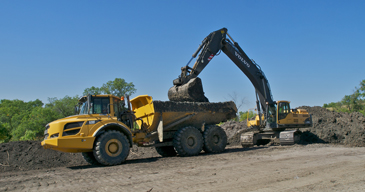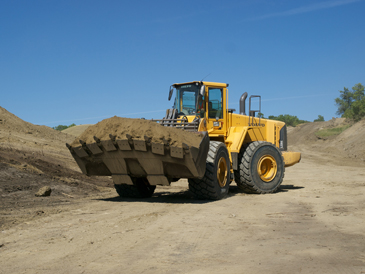Volvo customer Double K Excavating is installing a major water intake pumping facility and more than 20 kilometers of water pipeline – providing water to a giant new potash mine in Saskatchewan.
Although Saskatchewan now lies far from any significant body of water, in pre-historic times this Canadian province was the site of a huge inland sea. Over time, the sea disappeared leaving behind one of the world’s largest underground deposits of potassium chloride, also known as potash – and it’s these deposits that K+S Potash Canada, (part of the K+S Group) is extracting.
The K+S Group is one of the world’s largest suppliers of fertilizer and salt producers. The new K+S Potash Canada mine is scheduled to go into production in 2016 –with a capacity of 2.86 million tonnes a year, a figure expected to be reached by 2023. Potash is mainly used in fertilizers – over 40 million tonnes was mined worldwide last year, a large proportion of which came from Saskatchewan.
K+S contracted Double K Excavating, a leading infrastructure construction company in western Canada to build a large coffer dam, a water intake structure and the trenching and installation of a high capacity 810 mm-wide pipeline to the mine, running across 13 miles (20km). When completed the water supply facility will be capable of pumping over 168 million liters of water a day. The water, pumped from the Buffalo Pound Reservoir, will be used for underground extraction at the new K+S Legacy potash mine, which is located between Bethune and Findlater.
A family affair
Double K Excavating Inc. was established in 1979 by the Koch family, initially specializing in installing septic tanks and cisterns. It’s head-quartered in Tuxford, a small community in southwest Saskatchewan. The company has a good relationship with equipment supplier Volvo Construction Equipment (Volvo CE) and its fleet consists of various tracked and wheeled excavators, wheel loaders, articulated trucks, motor graders and skid steers.
Before trenching could begin, thousands of cubic meters of rock overburden had to be removed, which was then used to build a kilometer-long cofferdam. This work was quickly achieved using a Volvo L220E-Series wheel loader and A30F-Series articulated hauler. Meanwhile, a Volvo EC210B-Series excavator and a small fleet of articulated haulers were soon digging earth from inside the cofferdam in preparation for the installation of the water intake. The haul road building and maintenance was left to the Volvo G960 motor grader.
The Buffalo Pound Reservoir is the main source of drinking water for the Saskatchewan cities of Regina and Moose Jaw as well as many of the surrounding communities, so extreme care was needed when working in and around the water. Although varying with the landscape, trenching for the pipeline reached a maximum depth of 4.5 meters – aptly handled by a Volvo EC460C-Series and an EC360C-Series crawler excavator.
Volvo’s crawler excavators are ideally suited for work in the toughest quarrying, mining, road building and general construction jobs. Featuring a robust undercarriage and a reinforced boom/arm and superstructure, these machines are safe, efficient and durable. High breakout and crowding force is supported by an advanced hydraulic system that enables smooth, responsive digging and lifting, making it the ideal excavator for the trenching and pipeline installation. The EC460C-Series boasts a 235 kW (320 hp) Volvo Tier III compliant engine with V-ACT, offering high torque at low revs.
The Volvo L220 E-Series features an electronically controlled, high performance low emission Volvo engine, fully automatic countershaft transmission, a load-sensing hydraulic system, Volvo’s unique Torque Parallel linkage (TP linkage) and the comfortable Volvo Care Cab.
Can't compete with a Volvo
“We have used many other big brands but they just can’t compete with Volvo,” says Emerson Koch, CEO of Double K Excavating. “We have tough conditions here in this part of the world and there is no comparison in relation to fuel economy, performance, reliability, engine, transmission, drive train performance and reliability.”
“What won us over to Volvo was our first EC290 B-Series crawler excavator,” says Cole Koch, company vice-president and excavator operator. “It was one of the first machines I operated and it’s special to me, so much so that I have a permanent reminder of that machine tattooed on my arm. That machine is still an active member of our fleet today.”
This year will also see Double K Excavating use its Volvo fleet to move over half a million cubic meters of earth, install the infrastructure for two large residential subdivisions, replace and install more than 62 miles (100km) of domestic water and sewer lines and continue the installation of septic tanks and cisterns.
Source: Volvo CE

